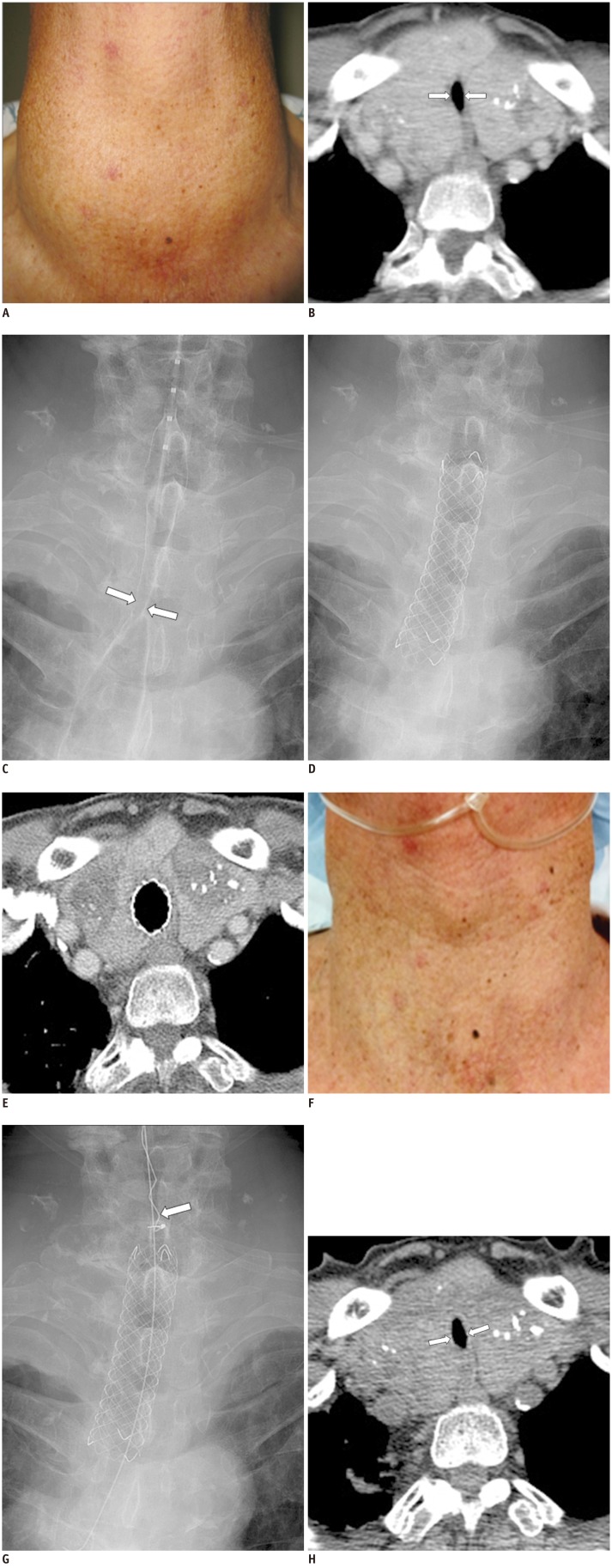1. Ríos A, Rodríguez JM, Canteras M, Galindo PJ, Tebar FJ, Parrilla P. Surgical management of multinodular goiter with compression symptoms. Arch Surg. 2005; 140:49–53. PMID:
15655205.

2. Kim WK, Shin JH, Kim JH, Song JW, Song HY. Management of tracheal obstruction caused by benign or malignant thyroid disease using covered retrievable self-expandable nitinol stents. Acta Radiol. 2010; 51:768–774. PMID:
20707660.

3. Noppen M, Poppe K, D'Haese J, Meysman M, Velkeniers B, Vincken W. Interventional bronchoscopy for treatment of tracheal obstruction secondary to benign or malignant thyroid disease. Chest. 2004; 125:723–730. PMID:
14769757.

4. Schmidt B, Olze H, Borges AC, John M, Liebers U, Kaschke O, et al. Endotracheal balloon dilatation and stent implantation in benign stenoses. Ann Thorac Surg. 2001; 71:1630–1634. PMID:
11383812.

5. Noppen M, Meysman M, Dhondt E, Gepts L, Velkeniers B, Vanhaelst L, et al. Upper airway obstruction due to inoperable intrathoracic goitre treated by tracheal endoprosthesis. Thorax. 1994; 49:1034–1036. PMID:
7974300.

6. Kim JH, Shin JH, Song HY, Shim TS, Yoon CJ, Ko GY. Benign tracheobronchial strictures: long-term results and factors affecting airway patency after temporary stent placement. AJR Am J Roentgenol. 2007; 188:1033–1038. PMID:
17377041.

7. Shin JH, Kim SW, Shim TS, Jung GS, Kim TH, Ko GY, et al. Malignant tracheobronchial strictures: palliation with covered retrievable expandable nitinol stent. J Vasc Interv Radiol. 2003; 14:1525–1534. PMID:
14654487.

8. Baek JH, Lee JH, Valcavi R, Pacella CM, Rhim H, Na DG. Thermal ablation for benign thyroid nodules: radiofrequency and laser. Korean J Radiol. 2011; 12:525–540. PMID:
21927553.

9. Na DG, Lee JH, Jung SL, Kim JH, Sung JY, Shin JH, et al. Radiofrequency ablation of benign thyroid nodules and recurrent thyroid cancers: consensus statement and recommendations. Korean J Radiol. 2012; 13:117–125. PMID:
22438678.

10. Ha EJ, Baek JH, Lee JH. The efficacy and complications of radiofrequency ablation of thyroid nodules. Curr Opin Endocrinol Diabetes Obes. 2011; 18:310–314. PMID:
21841482.

11. Jeong WK, Baek JH, Rhim H, Kim YS, Kwak MS, Jeong HJ, et al. Radiofrequency ablation of benign thyroid nodules: safety and imaging follow-up in 236 patients. Eur Radiol. 2008; 18:1244–1250. PMID:
18286289.

12. Baek JH, Kim YS, Lee D, Huh JY, Lee JH. Benign predominantly solid thyroid nodules: prospective study of efficacy of sonographically guided radiofrequency ablation versus control condition. AJR Am J Roentgenol. 2010; 194:1137–1142. PMID:
20308523.

13. Valcavi R, Riganti F, Bertani A, Formisano D, Pacella CM. Percutaneous laser ablation of cold benign thyroid nodules: a 3-year follow-up study in 122 patients. Thyroid. 2010; 20:1253–1261. PMID:
20929405.

14. Shin JH, Song HY, Kim JH, Kim SB, Lee GH, Park SI, et al. Comparison of temporary and permanent stent placement with concurrent radiation therapy in patients with esophageal carcinoma. J Vasc Interv Radiol. 2005; 16:67–74. PMID:
15640412.

15. Kim JH, Shin JH, Song HY, Ohm JY, Lee JM, Lee DH, et al. Palliative treatment of inoperable malignant tracheobronchial obstruction: temporary stenting combined with radiation therapy and/or chemotherapy. AJR Am J Roentgenol. 2009; 193:W38–W42. PMID:
19542381.

16. Spiezia S, Garberoglio R, Milone F, Ramundo V, Caiazzo C, Assanti AP, et al. Thyroid nodules and related symptoms are stably controlled two years after radiofrequency thermal ablation. Thyroid. 2009; 19:219–225. PMID:
19265492.

17. Kim HY, Ryu WS, Woo SU, Son GS, Lee ES, Lee JB, et al. Primary papillary thyroid carcinoma previously treated incompletely with radiofrequency ablation. J Cancer Res Ther. 2010; 6:310–312. PMID:
21119260.





 PDF
PDF ePub
ePub Citation
Citation Print
Print


 XML Download
XML Download